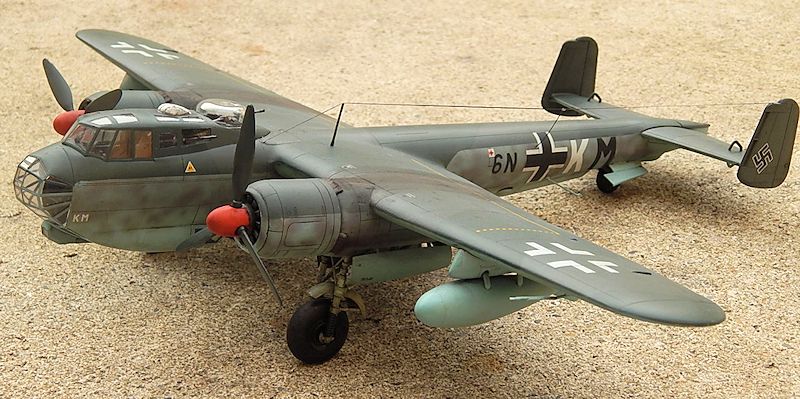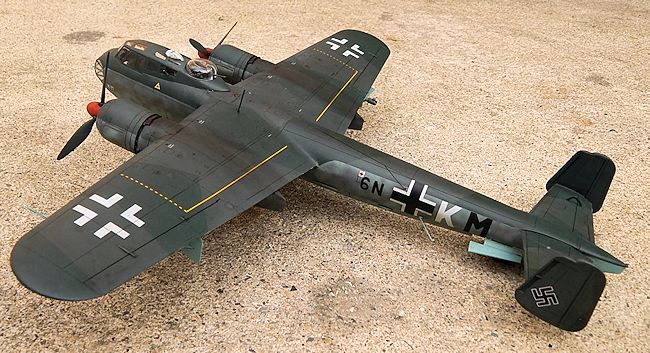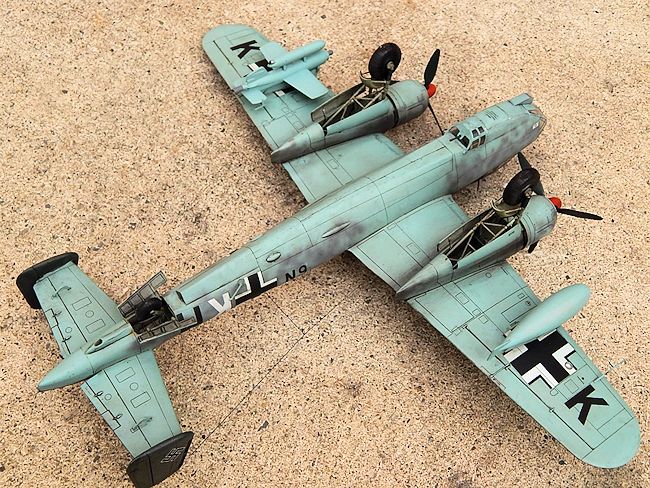
Revell 1/48 Do-217E-5
| KIT #: | 04557 |
| PRICE: | €25.00 at a German model show |
| DECALS: | Two options |
| REVIEWER: | Pierre-Andre Boillat |
| NOTES: | Also released as a Monogram/ProModeller kit |

| HISTORY |
 The Dornier
217 E-series twin-engine bombers were direct descendants of the famed Do 17
« flying pencil » of late 1930’s fame. Powered by a pair of BMW 801 air-cooled
14 cylinder radial engines, the new design had much improved speed, bomb load,
operational ceilling and range, the E-1 joining bomber units in 1941.
The Dornier
217 E-series twin-engine bombers were direct descendants of the famed Do 17
« flying pencil » of late 1930’s fame. Powered by a pair of BMW 801 air-cooled
14 cylinder radial engines, the new design had much improved speed, bomb load,
operational ceilling and range, the E-1 joining bomber units in 1941.
After the failure of the He-177 « Greif », it remained the most capable bomber
in German inventory and remained in service until war’s end.
The subject of this kit, E-5, was a dedicated version for anti-shipping
missions, equipped with a
Henschel Hs 293 glide
bomb and
a drop tank under the wings (the tank counter-balancing the missile’s weight and
improving the aircraft’s range), as well as radio guidance and control
transmitter systems for the missile. A total of 101 E-5s were either new built
or refitted from E-4 airframes. The type was used mainly from air bases on the
French Atlantic Coast and in the Mediterranean, posing a serious threat to
Allied shipping.
| THE KIT |

| CONSTRUCTION |
 The provided
engines simplified, but, as they will be hidden behind the BMW 801 trademark
cooling fans inside very tight, streamlined cowlings, it’s not a problem either.
The provided
engines simplified, but, as they will be hidden behind the BMW 801 trademark
cooling fans inside very tight, streamlined cowlings, it’s not a problem either.
As said above, assembling the airframe is a little tricky due to the parts’ size
and some warping (at least on my exemple). The kit’s main drawback (in my
opinion) is an ugly joint in the middle of the wing upper surfaces which,
coupled with said warping, will cause a slight depression in what should be a
smooth and straight surface (especially on a no-dihedral plane like the
Dornier). Correcting this will require quite an amount of putty (or the
insertion of plastic profiles inside the wings to straighten things up,
something I didn’t do).
After the mainframe was done, I filled every seam and waited for the putty to
dry (in fact, I built one or two small kits in-between, as a break from what was
to be this year’s Magna Opus. When I
felt ready, I sanded everything smooth and started with the (for me) fun part:
| COLORS & MARKINGS |
After sealing the paint job with a coat of Klear, I added the decals for the
chosen version, a machine of 4./ KG100 based at Cognac, France, in October 1943.
Swastikas (absent on this German product) were taken from an aftermarket sheet.
| FINAL CONSTRUCTION |
 After
sealing the decals with a second coat of Klear, I treated the model with my
usual wash of Cobra-brand, water soluble oils. When this was polished-out with
soft tissue, I added the breakable parts that wouldn’t withstand the
proceedings, such as landing gear, props and external loads. The wheels are
represented with slightly “weighted” tires, a nice touch of realism given the
bulk of the aircraft. The Hs 293 glide bomb being a one-way, high-tech piece of
ordinance, I left it un-weathered, like the drop tank which was most probably
jettisoned over the ocean upon dropping the missile, and had little chances of
being recovered and re-used.
After
sealing the decals with a second coat of Klear, I treated the model with my
usual wash of Cobra-brand, water soluble oils. When this was polished-out with
soft tissue, I added the breakable parts that wouldn’t withstand the
proceedings, such as landing gear, props and external loads. The wheels are
represented with slightly “weighted” tires, a nice touch of realism given the
bulk of the aircraft. The Hs 293 glide bomb being a one-way, high-tech piece of
ordinance, I left it un-weathered, like the drop tank which was most probably
jettisoned over the ocean upon dropping the missile, and had little chances of
being recovered and re-used.
Exhausts can be represented visible or covered with flame-dampers. As my
reference pics didn’t show the latter on any daylight maritime Dornier, I let
them aside.
Transparencies were added last. The main canopy unit got a special treatment, as
it has large areas that had to be masked and spray-painted, first in the
interior, then in the camo colors (had to take care that they fit the scheme).
The rest of the framing job was done with pre-painted decal stripes – quite a
chore on the multi-faceted “glasshouse” nose.
Lastly, antenna masts were added and the kit was given its final coat of Vallejo
matte lacquer. The long antenna wire is a piece of Lycra thread, which is less
prone to breaking when the kit is carried around.
| CONCLUSIONS |
 The Revell/Monogram
Do 217E is a truly fine kit with superb detail and the brand’s high standard of
quality. Though not a beginner’s kit due to its sheer bulk, assembly layout and
a few areas that require some planning and care, it will produce an impressive
piece that is guaranteed to draw attention when put on display. It perfectly
recaptures the sleek, elegant-yet-menacing lines of the original. Highly
recommended to fans of maritime bombers, the Luftwaffe, WWII classics or just
beautiful aircraft.
The Revell/Monogram
Do 217E is a truly fine kit with superb detail and the brand’s high standard of
quality. Though not a beginner’s kit due to its sheer bulk, assembly layout and
a few areas that require some planning and care, it will produce an impressive
piece that is guaranteed to draw attention when put on display. It perfectly
recaptures the sleek, elegant-yet-menacing lines of the original. Highly
recommended to fans of maritime bombers, the Luftwaffe, WWII classics or just
beautiful aircraft.
And lastly: this model was supposed to take part in the Modeling Madness “Battle
of the Atlantic” contest but wasn’t finished in time. In return, you got this
review. Hope you enjoyed it.
| REFERENCES |
Sources: Wikipedia – Monogram “German Aircraft Colours” – various internet
pages.
January 2015
If you would like your product reviewed fairly and fairly quickly, please contact the editor or see other details in the Note to Contributors.